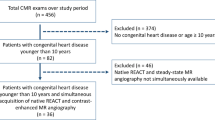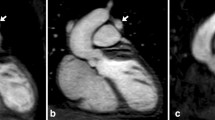Abstract
Background
In patients with Kawasaki disease (KD) serial evaluation of the distribution and size of coronary artery aneurysms (CAA) is necessary for risk stratification and therapeutic management.
Objective
To apply whole-heart coronary MR angiography (CMRA) and black-blood coronary vessel wall imaging in children with KD.
Materials and methods
Six children (mean age 4.6 years, range 2.5–7.8 years) with KD underwent CMRA using a free-breathing, T2-prepared, three-dimensional steady-state free-precession (3D-SSFP), whole-heart approach with navigator gating and tracking. Vessel walls were imaged with an ECG-triggered and navigator-gated double inversion recovery (DIR) black-blood segmented turbo spin-echo sequence.
Results
There was complete agreement between CMRA and conventional angiography (n=6) in the detection of CAA (n=15). Excellent agreement was found between the two techniques in determining the maximal diameter (mean difference 0.2±0.7 mm), length (mean difference 0.1±0.8 mm) and distance from the ostium (mean difference −0.8±2.1 mm) of the CAAs. In all subjects with a CAA, abnormally thickened vessel walls were found (2.5±0.5 mm).
Conclusions
CMRA accurately defines CAA in free-breathing sedated children with KD using the whole-heart approach and detects abnormally thickened vessel walls. This technique may reduce the need for serial X-ray coronary angiography, and improve risk stratification and monitoring of therapy.




Similar content being viewed by others
References
Kato H, Ichinose E, Yoshioka F et al (1982) Fate of coronary aneurysms in Kawasaki disease: serial coronary angiography and long-term follow-up study. Am J Cardiol 49:1758–1766
Kato H, Sugimura T, Akagi T et al (1996) Long-term consequences of Kawasaki disease. A 10- to 21-year follow-up study of 594 patients. Circulation 94:1379–1385
Geva T, Kreutzer J (2001) Diagnostic pathways for evaluation of congenital heart disease. In: Crawford MH, DiMarco JP (eds) Cardiology. Mosby International, London, pp 7–41
Vitiello R, McCrindle BW, Nykanen D et al (1998) Complications associated with pediatric cardiac catheterization. J Am Coll Cardiol 32:1433–1440
Post JC, Van RA, Bronzwaer JG et al (1995) Magnetic resonance angiography of anomalous coronary arteries. A new gold standard for delineating the proximal course? Circulation 92:3163–3171
McConnell MV, Ganz P, Selwyn AP et al (1995) Identification of anomalous coronary arteries and their anatomic course by magnetic resonance coronary angiography. Circulation 92:3158–3162
Kim WY, Danias PG, Stuber M et al (2001) Coronary magnetic resonance angiography for the detection of coronary stenoses. N Engl J Med 345:1863–1869
Molinari G, Sardanelli F, Zandrino F et al (2000) Value of navigator echo magnetic resonance angiography in detecting occlusion/patency of arterial and venous, single and sequential coronary bypass grafts. Int J Card Imaging 16:149–160
Greil GF, Stuber M, Botnar RM et al (2002) Coronary magnetic resonance angiography in adolescents and young adults with kawasaki disease. Circulation 105:908–911
Mavrogeni S, Papadopoulos G, Douskou M et al (2004) Magnetic resonance angiography is equivalent to X-ray coronary angiography for the evaluation of coronary arteries in Kawasaki disease. J Am Coll Cardiol 43:649–652
Newburger JW, Takahashi M, Gerber MA et al (2004) Diagnosis, treatment, and long-term management of Kawasaki disease: a statement for health professionals from the Committee on Rheumatic Fever, Endocarditis and Kawasaki Disease, Council on Cardiovascular Disease in the Young, American Heart Association. Circulation 110:2747–2771
Fischer SE, Wickline SA, Lorenz CH (1999) Novel real-time R-wave detection algorithm based on the vectorcardiogram for accurate gated magnetic resonance acquisitions. Magn Reson Med 42:361–370
Weber OM, Martin AJ, Higgins CB (2003) Whole-heart steady-state free precession coronary artery magnetic resonance angiography. Magn Reson Med 50:1223–1228
Botnar RM, Stuber M, Kissinger KV et al (2000) Noninvasive coronary vessel wall and plaque imaging with magnetic resonance imaging. Circulation 102:2582–2587
Kim WY, Stuber M, Bornert P et al (2002) Three-dimensional black-blood cardiac magnetic resonance coronary vessel wall imaging detects positive arterial remodeling in patients with nonsignificant coronary artery disease. Circulation 106:296–299
Fayad ZA, Fuster V, Fallon JT et al (2000) Noninvasive in vivo human coronary artery lumen and wall imaging using black-blood magnetic resonance imaging. Circulation 102:506–510
Fleckenstein JL, Archer BT, Barker BA et al (1991) Fast short-tau inversion-recovery MR imaging. Radiology 179:499–504
Stuber M, Botnar RM, Danias PG et al (1999) Double-oblique free-breathing high resolution three-dimensional coronary magnetic resonance angiography. J Am Coll Cardiol 34:524–531
Etienne A, Botnar RM, Van Muiswinkel AM et al (2002) “Soap-Bubble” visualization and quantitative analysis of 3D coronary magnetic resonance angiograms. Magn Reson Med 48:658–666
McConnell MV, Khasgiwala VC, Savord BJ et al (1997) Comparison of respiratory suppression methods and navigator locations for MR coronary angiography. AJR 168:1369–1375
Research Committee on Kawasaki Disease (1984) Report of the subcommittee on standardization of diagnostic criteria and reporting of coronary artery lesions in Kawasaki disease. Ministry of Health and Welfare, Tokyo, Japan
de Zorzi A, Colan SD, Gauvreau K et al (1998) Coronary artery dimensions may be misclassified as normal in Kawasaki disease. J Pediatr 133:254–258
Kurotobi S, Nagai T, Kawakami N et al (2002) Coronary diameter in normal infants, children and patients with Kawasaki disease. Pediatr Int 44:1–4
Bland JM, Altman DG (1986) Statistical methods for assessing agreement between two methods of clinical measurement. Lancet 1:307–310
Newburger JW, Takahashi M, Beiser AS et al (1991) A single intravenous infusion of gamma globulin as compared with four infusions in the treatment of acute Kawasaki syndrome. N Engl J Med 324:1633–1639
Holman RC, Curns AT, Belay ED et al (2003) Kawasaki syndrome hospitalizations in the United States, 1997 and 2000. Pediatrics 112:495–501
Sorensen TS, Korperich H, Greil GF et al (2004) Operator-independent isotropic three-dimensional magnetic resonance imaging for morphology in congenital heart disease: a validation study. Circulation 110:163–169
Barkhausen J, Hunold P, Jochims M et al (2002) Comparison of gradient-echo and steady state free precession sequences for 3D-navigator MR angiography of coronary arteries. Rofo 174:725–730
Leiner T, Katsimaglis G, Yeh EN et al (2005) Correction for heart rate variability improves coronary magnetic resonance angiography. J Magn Reson Imaging 22:577–582
Suzuki A, Miyagawa-Tomita S, Komatsu K et al (2000) Active remodeling of the coronary arterial lesions in the late phase of Kawasaki disease: immunohistochemical study. Circulation 101:2935–2941
McMahon CJ, Su JT, Taylor MD et al (2005) Images in cardiovascular medicine. Detection of active coronary arterial vasculitis using magnetic resonance imaging in Kawasaki disease. Circulation 112:e315–e316
Costello JM, Wax DF, Binns HJ et al (2003) A comparison of intravascular ultrasound with coronary angiography for evaluation of transplant coronary disease in pediatric heart transplant recipients. J Heart Lung Transplant 22:44–49
Ferencik M, Nomura CH, Maurovich-Horvat P et al (2006) Quantitative parameters of image quality in 64-slice computed tomography angiography of the coronary arteries. Eur J Radiol 57:373–379
Kuettner A, Beck T, Drosch T et al (2005) Diagnostic accuracy of noninvasive coronary imaging using 16-detector slice spiral computed tomography with 188 ms temporal resolution. J Am Coll Cardiol 45:123–127
Pohle K, Achenbach S, Macneill B et al (2006) Characterization of non-calcified coronary atherosclerotic plaque by multi-detector row CT: comparison to IVUS. Atherosclerosis 190:174–180
Brenner D, Elliston C, Hall E et al (2001) Estimated risks of radiation-induced fatal cancer from pediatric CT. AJR 176:289–296
Acknowledgements
We thank the “EHLKE” foundation and “Stiftung zur Förderung der Erforschung von Zivilisationserkrankungen”, Baden-Baden, Germany, for financial support. We also thank F. Uhlemann, MD, Olgahospital Stuttgart, Germany, for providing the X-ray angiogram of one of the patients with KD.
Author information
Authors and Affiliations
Corresponding author
Electronic supplementary material
Below is the link to the electronic supplementary material.
Movie 1
A 3-D, volume-rendered, isotropic, whole-heart, steady-state free-precession dataset of a 7.8-year-old patient (see Figs. 1 and 2) with severe impairment of the RCA was imaged without the use of contrast agent. The origin of the RCA and the course within the atrioventricular groove are shown (AVI 49337 kb)
Rights and permissions
About this article
Cite this article
Greil, G.F., Seeger, A., Miller, S. et al. Coronary magnetic resonance angiography and vessel wall imaging in children with Kawasaki disease. Pediatr Radiol 37, 666–673 (2007). https://doi.org/10.1007/s00247-007-0498-x
Received:
Revised:
Accepted:
Published:
Issue Date:
DOI: https://doi.org/10.1007/s00247-007-0498-x




